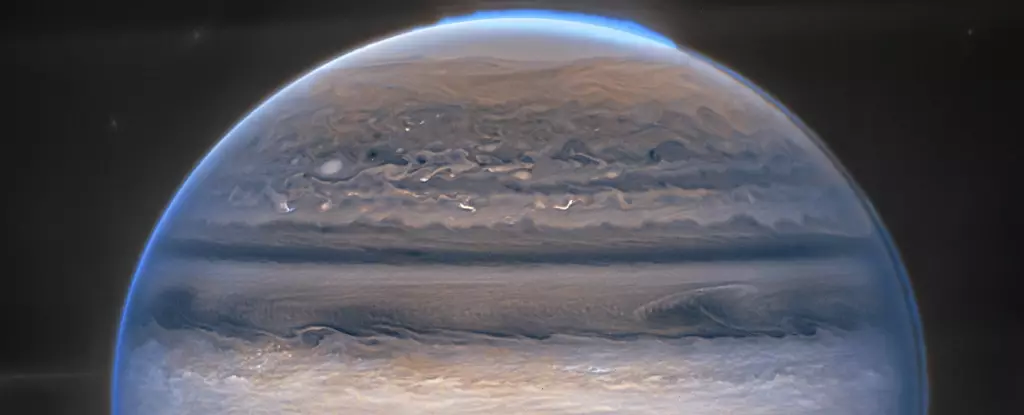In the vast expanse of our solar system, Jupiter stands as a colossal enigma, captivating astronomers and physicists alike with its unique characteristics. Unlike terrestrial planets such as Earth or Mars, Jupiter lacks a solid surface. No solid ground exists for humans or spacecraft to rest upon. This absence prompts a multitude of questions: How does this massive planet maintain its structure? What lies beneath its turbulent atmosphere? As the Juno probe continues its exploration, now entering its ninth year around the giant gas planet, we delve deeper into the mysteries of Jupiter.
Jupiter is the fifth planet from the Sun and the largest in our solar system, so large it can accommodate over 1,000 Earths. Such immense size renders it a gas giant, primarily consisting of hydrogen and helium, which closely mirrors the Sun’s own composition. This gaseous world is characterized by its dynamic and chaotic atmosphere, marked by phenomenon like the Great Red Spot—a storm that has raged for centuries. Winds on Jupiter can reach speeds of more than 400 mph, dwarfing even the fiercest hurricanes on Earth.
In contrast to rocky planets, the architecture of Jupiter reveals a gradual descent into its interior, where pressure and temperature escalate exponentially. Just as a journey through Earth’s atmosphere leads to a solid ground, descending through Jupiter’s atmosphere could lead one to feel the crushing weight of gases. Unlike on Earth, the deeper one travels into Jupiter, the environment becomes increasingly hostile. To explore this gas giant is to understand that individuals would not merely drown; rather, the overwhelming pressure would crush them before they ever approached a firm surface.
Examining the layers of Jupiter unveils a fascinating transformation. About 1,000 miles beneath its swirling atmosphere, hydrogen transitions from a gaseous state to a liquid form, creating what scientists describe as the largest ocean in the solar system—albeit one devoid of water. Continuing deeper into Jupiter, at approximately 20,000 miles down, the hydrogen behaves more like an exotic liquid metal—a state so unusual that scientists have only recently managed to replicate it in laboratory conditions. Here, electrons are freed from their atomic confines, illustrating a revolutionary state of matter.
It is crucial to note that the transition between these states is not marked by boundaries or surfaces. The shifts are fluid, elucidating the idea that Jupiter’s core is far from conventional. The core itself, although not strictly defined, is believed to comprise a hot, dense amalgam of liquid and solid materials. While the exact nature of this core is still debated among scientists, one certainty stands: the tremendous pressure—estimated at 100 million times that of Earth’s atmosphere—combined with scorching temperatures reaching as high as 35,000 degrees Fahrenheit, makes any theoretical exploration of the core profoundly challenging.
Though undeniably inhospitable, Jupiter plays an essential role in safeguarding our solar system. Its immense gravitational field serves as a natural shield for the inner planets, including Earth. Over millions of years, Jupiter has gravitationally diverted numerous asteroids and comets that could have impacted the delicate ecosystems of our planet. This protective function has been vital in shaping the course of life on Earth, theoretically preventing what could have been extinction-level events, akin to the cataclysm that wiped out the dinosaurs.
This suggests that while life as we know it could not thrive on Jupiter due to its harsh conditions, its presence in our solar system may have been instrumental in the emergence of life on Earth. Ironically, this colossal gas giant, often viewed as a formidable and hostile entity, has potentially played a pivotal role in allowing humanity to exist.
In stark contrast to its ominous atmosphere, Jupiter’s moons offer tantalizing possibilities. Europa, one of Jupiter’s largest moons, is particularly noteworthy. Beneath its icy surface lies an underground ocean, prompting scientists to speculate whether life could exist in those hidden waters. With the upcoming NASA Europa Clipper mission set to launch in October 2024, scientists aim to gather unprecedented data about this icy moon during its numerous flybys. Could living organisms navigate the depths of Europa’s subsurface ocean? The answer remains elusive, as the probe won’t reach its destination until 2030.
As we continue to unravel the layers of curiosity surrounding Jupiter, it remains clear that this majestic planet is not merely a backdrop in our solar system; it is a critical player in the grand saga of cosmic evolution, elevating our understanding of life’s potential beyond Earth. The journey into Jupiter’s mysteries is far from over, and what we discover might redefine our understanding of planetary science, life, and our place in the universe.

